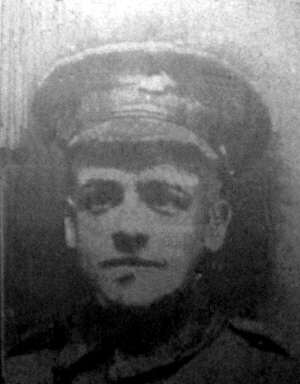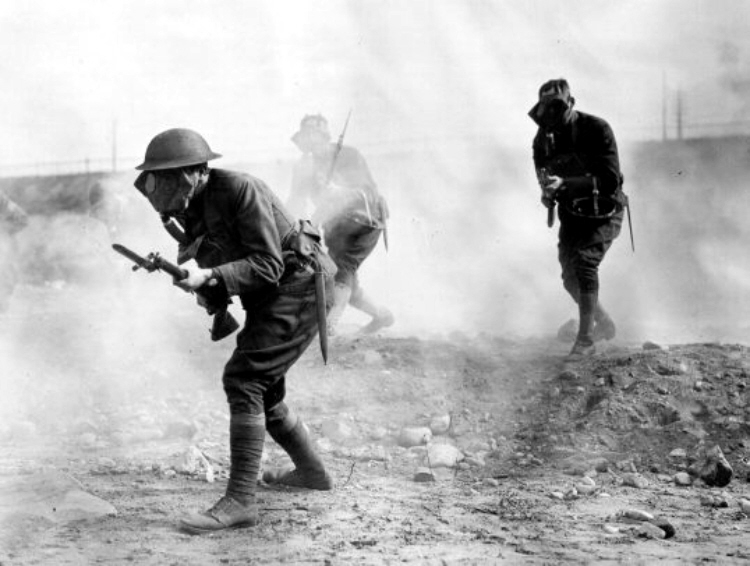
Louis Harrison was born in Ossett in late 1895, the second child and the only son of South Yorkshire couple Fred Harrison and his wife Emily (nee Stirling), who married in 1893. The couple had three children from their marriage, two girls and a boy, all born in Ossett.
In 1901 the family were living on Horbury Road, Ossett close to Sowood Farm. Fred Harrison was working as an insurance agent. By 1911 Fred and Emily have three children and they were now living at 3, Clarendon Cottages, Horbury Road, Ossett. Louis, aged 15, was a school boy, but later worked in his own right in the rag trade.
Louis Harrison’s army service record has not survived, but it is known that he enlisted in Dewsbury, and that he was posthumously awarded the British and Victory medals, but not the 1914/15 Star, which indicates that he did not serve overseas before 31st December 1915. His medal card also bears an earlier KOYLI service number 5413 in addition to number 203168.
The Territorial 1/4th Battalion of KOYLI was formed in August 1914 at Wakefield as a part of the 3rd West Riding Brigade, West Riding Division. They moved on mobilisation to Doncaster and in November 1914 to Gainsborough then on to York in February 1915. On the 12th of April 1915 they landed at Boulogne and on the 15th May 1915, the formation became 148th Brigade, 49th (West Riding) Division.
Private Lewis Harrison, aged 24 years, died in hospital on the 24th July 1917 as a result of being gassed on the 21st July, whilst in the trenches at Nieuport.
On the 13th July, two KOYLI battalions marched from Annezin to Bethune station to entrain for Dunkerque, where they arrived in the course of the afternoon. They proceeded in barges to Zuydecoote (spending the night in the barges.) Next day they marched to Bray Dunes, taking over some of the coast defences there. On the 18th July, a week after the 2nd Battalion had experienced their hard fighting there, both Territorial battalions (1/4 and 1/5) were in occupation of the Nieuport defences. The 1/5th Battalion were in front line with the 1/4th Battalion in support. The former had several casualties in its “A” and “C” Companies on the 18th July.
On the 20th July, there was again a destructive bombardment. A day or two later, a heavy bombardment descended on the defences in the night of the 21/22nd July 1917. The enemy used shells of all calibres and included a large quantity of his new (mustard) gas shells. The 1st/4th Battalion, in support, were the chief sufferers. The gas attack was repeated twice. The gas smelt of garlic or mustard, and was the chief cause of an overwhelming number of casualties. The immediate effect was a slight irritation of the nose and throat. Sneezing ensued, followed by vomiting, and the eyes became acutely inflamed and very painful. Coughing and symp toms resembling bronchitis followed and prevailed for a week, at least, after contact with the gas. In the 4th Battalion the casualties were 7 killed, 9 wounded, 423 gassed and 3 missing. Private Lewis Harrison was one of those gassed.
The 1/4th KOYLI were relieved on the 23rd July and bivouacked that night in a field on the outskirts of Nieuport before being taken by bus taken on the 25th July to Ghyvelde, where the battalion remained for the rest of the month.1
The “Ossett Observer” 2 had this obituary for Louis Harrison:
“A well respected South Ossett young man, Private Lewis Harrison (21), of the King’s Own Yorkshire Light Infantry, the only son of Mr. Fred Harrison, insurance agent, of Clarendon-cottage, off Horbury-road, has lost his life in the operations. According to the official notice, which was received by his parents on Tuesday, his death on the 24th July is attributed to a gas shell. A former choirboy at Christ Church, South Ossett, and a scholar of the South Ossett Church day school, as a lad he gained a scholarship tenable at the Grammar School. At the time he joined the army in June last year, he was engaged in the rag trade on his own account. He proceeded to France last December and had been in and out of the trenches since. Deceased was of a quiet, retiring disposition, a regular worshipper at Christ Church, South Ossett, and a teacher in the Sunday school.”

Above: WW1 Mustard Gas attack, which was used at Nieuport when Private Louis Harrison was gassed.
Private Louis Harrison died on the 24th July 1917, aged 21 years, the son of Fred and Emily Harrison of Clarendon Cottages, Horbury Road, Ossett and is buried at grave reference 807 at the Adinkerke Churchyard Extension,3 De Panne, West-Vlaanderen, Belgium. The village of Adinkerke is located west of the town of Veurne on the N39.
From June to November 1917, XV Corps held the front from the Belgian coast to St. Georges. The 24th and 39th Casualty Clearing Stations were posted at Oosthoek (between Adinkerke and Furnes) from July to November, and the 1st Canadian Casualty Clearing Station was at Adinkerke for a short time in June.
Adinkerke Churchyard Extension is a Belgian Military Cemetery on the west side of the Churchyard. The Commonwealth graves are in two small plots and are numbered consecutively with the other graves.
The extension contains 67 Commonwealth burials of the First World War.
References:
1. “King’s Own Yorkshire Light Infantry in the Great War: 1914-1918” by R.C. Bond, Naval & Military Press, ISBN-13: 978-1843427636
2. “Ossett Observer”, 4th August 1917